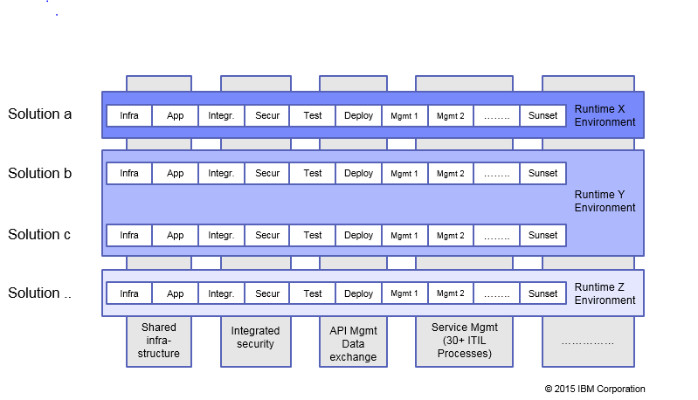
In essence, it is all IT Automation!
Agile, Continuous Delivery, SW defined environments, Cloud and DevOps. Paradigms, which have been around for some time now in the IT world. A lot has been published, however not everybody seems to realize that all these highly promising developments are based on a single foundation ==> IT Automation.
Why is this important to be aware off? A first reason could be that it gives a better understanding of how the benefits of this new thinking can be achieved. A second reason – and maybe even more important – is the recognition of what extended IT Automation implies, and what will be the impact on an organization and its employees.
IT Automation in the context of Cloud, DevOps etc. is based on the assumption that all phases of the solution life cycle are covered and captured in strings of code. So not only the application, but also infrastructure, testing, build etc. One could visualize this as a long script[1] with consists of multiple blocks of code, which each take care of part of the solution. These are the horizontal strings in the illustration.
With these strings available, one is able to instantly deploy a solution either from a local environment Private Cloud) or from the internet (Public Cloud). Automation can also facilitate application or infrastructure updates in short daily, or weekly cycles, including automated testing in a reliable way (DevOps and Agile).
With automation in place it will be much easier to offer reliable services and consistent quality. Human errors are largely avoided. And if they are still there – captured in the code – then it will be possible to trace and resolve them in a more structured and methodical way.
In the past we tried to improve quality with better agreements and procedures. Agreements and procedures were mostly in writing, to be followed and interpreted by humans. However we all know that a lot can go wrong with that. People don’t like to read a lot or don’t have the time for it. Automation is not impacted by either interpretation or time constraints. A properly tested coded instruction is always completely executed in a very short time.
One has however to realize that there are many relationships between the individual solution deployment scrips. First of all, every script will need a runtime environment. Obviously an organization wants to have only a limited number of those. Secondly, solutions will have to exchange data. This needs to be secure, and provided by a limited number of integrations. Management is also needed. ITIL has recognized more than 30 management processes, which will have to be covered, even if it is only minimal. These relationships are visible in the vertical layers in the illustration.
This implies that there will be huge need for planning, standardization, governance and related activities. On a higher level (Architecture) and in detail (Development & Operations)
Not everybody will also embrace this, given the point that Agile and DevOps are seen as a new way to collaborate without to many constraints. Solutions will therefore have to be found to give Scrum teams freedom to operate within certain boundaries.
In the traditional world, automation does already play a role, both on the development and operational side. Scripts to build applications, servers or install monitoring agents, are probably in place to some extent. People do like to make things easier and more efficient. However groups, in their silos, have considerable freedom to execute and optimize just their part of the whole. Humans are the glue to integrate and correct if needed. And that is something we are really good at. We can learn, improvise, think ahead etc.
This will need to change. All the human ingenuity has to go into the automated scripts. This implies that a lot of thinking has to be done before one can even start building a first version of a script. And that first version will be far from perfect. So optimization and improvement activities will be needed on a massive scale; plenty of work for us all.
And, last but not least, that work will probably be more attractive! Routine, semi-automated work, will get replaced by participating in a methodical approach to optimize and improve IT execution. So boring repeating activity, searching for random errors and finding imperfect solutions, will go and will be replaced by more demanding and creative tasks, which really bring a 100% result.
IT Automation is foundational to many of the new promising paradigms. It is important to understand this, because it gives insight in how the benefits can be achieved. But it is also obvious that IT Automation will require different thinking and organizing to ensure that all will be really integrated, effective and efficient.
Jobs and skills will have to change drastically. That can and should be seen as challenge. Maybe a bit threatening for some, however I am convinced that it will be a change for the better. For the world and for ourselves! :-)
[1] Script will be - strictly speaking - not a correct word in most cases. In practice there are many different options, depending on the technique offered.